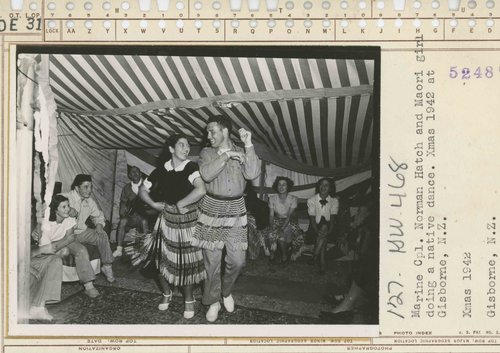
By Allie Webber (Kapiti US Marine Trust)
His efforts ended with, an Academy Award for footage so brutal that it took special permission from President Franklin Roosevelt to allow his documentary on the Battle of Tarawa to be shown to the American public in 1944.
Hatch said President Franklin Roosevelt agreed to the film’s release because he realised he had to let the American public know what was going on or he wouldn’t have their support.
Born in 1921 Hatch caught the photography bug at high school. He remembers he and his school friends in Gloucester, Massachusetts grabbing their cameras and heading to the Howard Theatre in Boston to secretly snap pictures of the Burlesque dancers on stage
Norm Hatch joined the Marine Corps in 1939 just as World War II began and was eager to put his photography skills to work.
By November 1943, Staff Sergeant Hatch, now a combat cameraman, was heading for the Pacific where, aged 22. He first spent the first 11 months in New Zealand, capturing footage of the Marines arriving, leaving, living, training and travelling – all on his hand-cranked 16mm movie camera.
Before leaving to film the Battle of Tarawa, Hatch and his team recorded over 16 reels of moving footage and almost 800 black and white photographs of the Marines so-called ‘friendly invasion’ of New Zealand.
The Battle of Tarawa lasted 76 hours from November 20- 23, 1943. On the eve of the battle, Hatch was bobbing in the waves in a small boat with his hand-held camera and just a pistol to protect himself – toward the tiny Pacific Ocean atoll, known as the Gilbert & Ellice Islands, now the Republic of Kiribati. The island and its airfield, were held by the Japanese, and had to be captured before the Marines could move on toward Japan.
Hatch and other USMC cameramen covered the fighting from the moment US Marines landed until the end. What he remembered most was “the overwhelming stench of the dead, and the thick black smoke”.
His footage shows Marines lying dead on a beach and floating on water – ‘just as they lay’. It was the first time this type of death had been shown to the American public.
After Tarawa was taken from the Japanese, his film was turned into newsreels in San Francisco, processed at Pearl Harbor and later picked up by all five US newsreel companies before being edited into the now famous award-winning documentary With the Marines at Tarawa – at Warner Bros studios in Hollywood.
About 15 months after the Battle of Tarawa, Hatch wound up with the Marines capturing moments from the Battle of Iwo Jima (19 February – 26 March 1945). This was a major battle in which the United States Marine Corps and United States Navy landed on and eventually captured the island of Iwo Jima from the Imperial Japanese Army during World War II.
Hero image: Marine Cpl. Norman Hatch and Maori girl doing a native dance. Xmas 1942 at Gisborne. NZ. (original caption) - S319498
About the Kapiti US Marines Trust
The Kapiti US Marines Trust (KUSMT) was established in 2010 to help promote the collection, conservation and exhibition of WWII Marines History in Kapiti and the Wellington region. “Our vision is to tell the story of the ‘friendly invasion’ of U.S. Armed forces in New Zealand, between 1942-44- for future generations. Events, exhibitions, and various exterior signage displays enable us to do this.” Marinenz.com